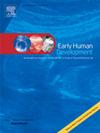在新生儿重症监护室停止自动氧气控制:一个5年的单中心真实世界的经验
IF 2
3区 医学
Q2 OBSTETRICS & GYNECOLOGY
引用次数: 0
摘要
目的:本研究将AOC整合为标准治疗,旨在评估现实世界单中心环境下的停药体验。方法本观察性研究在莱顿大学医学中心联合焦点小组,探讨护理人员停止AOC和重新开始的标准,回顾性分析接受AOC≥24小时的早产儿(24 - 37周)。本分析评估护理人员在停止AOC后48小时内关于停止AOC的决策,成功率和临床参数。结果终止决定是基于前24小时的FiO2水平和变异性。在172名婴儿中,成功率为78.5%,随胎龄(GA)的变化而变化:极端早产儿(28周)为50%,非常早产儿(28 - 32周)为84.8%,早产儿(32周)为84.0% (p < 0.001)。停药后48小时的临床参数在成功停药的婴儿和需要重新开始的婴儿之间存在差异。极早产儿表现出较低的SpO2水平,反映了停药后SpO2分布向左移动和重启阶段持续不稳定。非常早产的婴儿也表现出类似的变化,尽管不那么明显,而早产儿的SpO2水平维持在90%以上。进一步分析显示,极早产儿SpO2波动更大,在AOC重启后进一步增加。AOC重启后,所有GA亚组的FiO2变异性增加,其中极早产儿的增加最为显著。结论AOC停药成功率因胎龄不同而不同,极早产儿即使在AOC重启后仍难以维持稳定的氧合。本文章由计算机程序翻译,如有差异,请以英文原文为准。
Discontinuation of automated oxygen control in preterm infants in the NICU: A 5-year single centre real-world experience
Objective
With AOC integrated as standard care, this study aimed to evaluate the experience of discontinuation in a real-world single centre setting.
Methods
This observational study at Leiden University Medical Centre combined focus groups, which explored caregivers' criteria for AOC discontinuation and restart, with a retrospective analysis of preterm infants (24–37 weeks gestation) who received AOC for ≥24 h. This analysis assessed caregivers' decision-making regarding AOC discontinuation, success rate and clinical parameters within 48 hour post-discontinuation.
Results
Discontinuation decisions were based on FiO2 levels and variability over the preceding 24 h. Among 172 infants, the success rate was 78.5 %, varying by gestational age (GA): 50 % for extremely preterm (<28 weeks), 84.8 % for very preterm (28–32 weeks), and 84.0 % for preterm infants (>32 weeks) (p < 0.001).
Clinical parameters over the 48 hour post-discontinuation differed between infants who successfully discontinued and those requiring a restart. Extremely preterm infants showed lower SpO2 levels, reflecting a leftward shift in SpO2 distribution post-discontinuation and prolonged instability during the restart phase. Very preterm infants showed a similar shift, though less pronounced, while preterm infants maintained SpO2 levels above 90 %. Further analysis revealed extremely preterm infants exhibited greater SpO2 fluctuations, which further increases after AOC restart. Variability in FiO2 increased across all GA subgroups after AOC restart, with the most significant increase in extremely preterm infants.
Conclusion
AOC discontinuation success rates vary by GA, with extremely preterm infants facing the most difficulty maintaining stable oxygenation, even after AOC restart.
求助全文
通过发布文献求助,成功后即可免费获取论文全文。
去求助
来源期刊

Early human development
医学-妇产科学
CiteScore
4.40
自引率
4.00%
发文量
100
审稿时长
46 days
期刊介绍:
Established as an authoritative, highly cited voice on early human development, Early Human Development provides a unique opportunity for researchers and clinicians to bridge the communication gap between disciplines. Creating a forum for the productive exchange of ideas concerning early human growth and development, the journal publishes original research and clinical papers with particular emphasis on the continuum between fetal life and the perinatal period; aspects of postnatal growth influenced by early events; and the safeguarding of the quality of human survival.
The first comprehensive and interdisciplinary journal in this area of growing importance, Early Human Development offers pertinent contributions to the following subject areas:
Fetology; perinatology; pediatrics; growth and development; obstetrics; reproduction and fertility; epidemiology; behavioural sciences; nutrition and metabolism; teratology; neurology; brain biology; developmental psychology and screening.
 求助内容:
求助内容: 应助结果提醒方式:
应助结果提醒方式:


